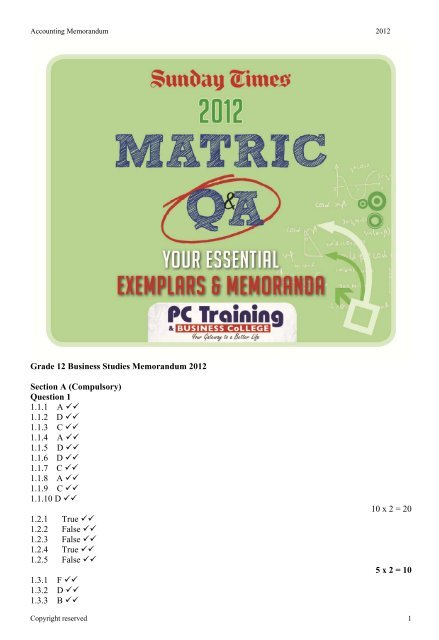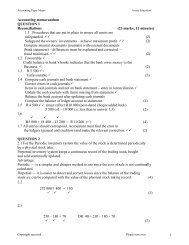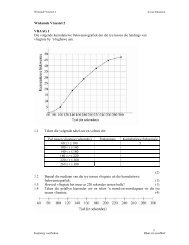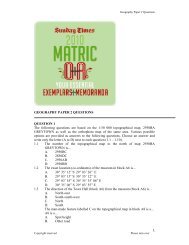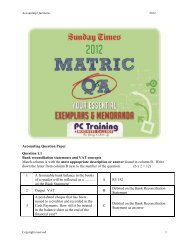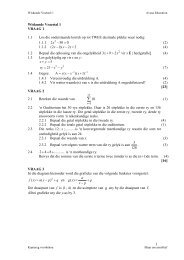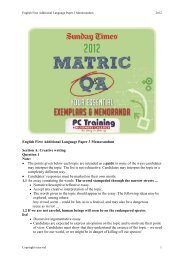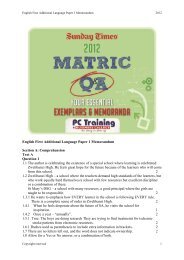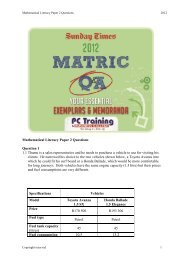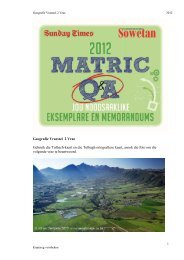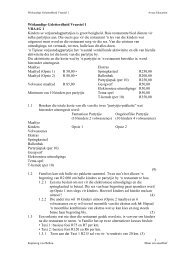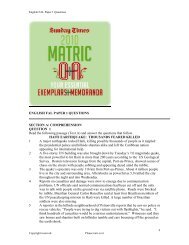Grade 12 Business Studies Memorandum 2012 - Times LIVE
Grade 12 Business Studies Memorandum 2012 - Times LIVE
Grade 12 Business Studies Memorandum 2012 - Times LIVE
You also want an ePaper? Increase the reach of your titles
YUMPU automatically turns print PDFs into web optimized ePapers that Google loves.
Accounting <strong>Memorandum</strong> 20<strong>12</strong><strong>Grade</strong> <strong>12</strong> <strong>Business</strong> <strong>Studies</strong> <strong>Memorandum</strong> 20<strong>12</strong>Section A (Compulsory)Question 11.1.1 A 1.1.2 D 1.1.3 C 1.1.4 A 1.1.5 D 1.1.6 D 1.1.7 C 1.1.8 A 1.1.9 C 1.1.10 D 1.2.1 True 1.2.2 False 1.2.3 False 1.2.4 True 1.2.5 False 1.3.1 F 1.3.2 D 1.3.3 B 10 x 2 = 205 x 2 = 10Copyright reserved 1
Accounting <strong>Memorandum</strong> 20<strong>12</strong>2.22.32.4o People (Social Responsibility) – assessment of CSR/CSI involvemento Planet (Environmental Sustainability) – an assessment of environmental impact (greenfootprint)o Profits (Economic Sustainability) – traditional financial reportingORo Management of financeso Management of social and environmental riskso Management of obligations and opportunities 6• Union strives to improve working conditions of employees• Union gets involved in the joint decision making with management• Protects employees from unfair dismissal, retrenchments etc• Serves as a monitor for the implementation of Legislations• Act on behalf of members in dispute resolution• Any relevant answer.5 x 2 = 10• The Human Resources Manager must prepare/evaluate job description• The Human Resource Manager must indicate the job specification. • A decision must be made as to whether recruitment should be internal.• If internal is unsuccessful then look at external recruitment. • If external, the Human Resources Manager must select the relevant recruitment sourcee.g. from recruitment agencies, tertiary institutions, or placing an advertisement in thenewspaper. • The advertisement must be prepared with the relevant information, e.g. The name of thecompany, contact details, name of the person to be contacted regarding the vacancy.• Place the advertisement in the appropriate media. • Accept any order in presentation of steps. Any 4 x 2 = 8OR• Recruitment Planning – job analysis is carried out. • Recruitment Action – how, where and when recruitment should take place and who willbe responsible. Several methods can be used. • Exploration of Human Resources – first step in the physical recruitment activity in therecruitment process. Internal and external sources can be used. • Screening – Applications are screened to find out if they qualify according torequirements of the post. • Provisionally Selected Applicants – List of qualifying applicants provides the humanresources department with provisionally selected applicants and it completes therecruitment process. Any 4 x 2 = 8OR• Recruitment • Selection • Placement • Induction • Allocate a maximum of 4 marks even if there are explanations. Any 4 x1 = 4Copyright reserved 3
Accounting <strong>Memorandum</strong> 20<strong>12</strong>2.5.1Interest = P x R x T= R15 000 x <strong>12</strong>/100 x <strong>12</strong>/<strong>12</strong> = R1 800 4Note:(a) Allocate maximum marks if only the answer of R1 800 is given (Max 4).(b) Allocate a maximum of 2 marks if procedure and method is correct but the final answer isincorrect.• Low risk because return is guaranteed. • The return of <strong>12</strong>% may be better than other forms of investment. • Any other relevant answer related to the reasons why the investment is good. 42.62.8• Risk takers • Creative thinkers, who challenge the conventional way of thinking • Good leaders, as they persuade others to buy into their idea • Passionate visionaries who believe they can do something others have nottried/succeeded at • Opportunists - who happen to be in the right place at the right time• Have perseverance and commitment • Independent spirits & are internally motivated • They either have the necessary skill, knowledge or expertise to make a success of thebusiness, or know how to hire the right people to fill their personal shortcomings. • Any four. 82.7.1 Public Company 22.7.2• Easy to establish and dissolve. • Inexpensive to establish. • Sharing of responsibilities and risks. • Makes provision for partners to make quick decisions/can easily adapt to variouseconomic challenges. • Few legal requirements. • Direct control over your business matters. • More capital can be gained. • Creditworthiness is higher because partners are jointly and severally responsible forliabilities of the partnership. • Allows for specialisation / Combination of different skills. • Can be easily converted to another form of ownership e.g. company. • Any other relevant answer related to advantages of a partnership. Any 3 x 2 = 6• Addressing and correcting imbalances in negotiating powers between consumers andcredit providers. • Discouraging reckless credit granting by credit providers. • Encouraging equity in the credit market. • Encouraging responsible borrowing and avoidance of over-indebtness. 60Copyright reserved 4
Accounting <strong>Memorandum</strong> 20<strong>12</strong>Question 33.1.1 Line graph 23.1.2 Lowest = R134.61 Highest – R136.95 43.1.3 The anticipation of an increase in profits as a result of the pre-Christmas purchases bycustomers caused many shareholders to buy Shoprite shares, which caused theshare price to rise. ORA drastic increase in prices during this period caused profits to increase andthus there was a greater demand for the Shoprite shares which caused the share price torise. 43.1.4 Loss 23.1.5• Serves as a link between investors and entrepreneurs • Serves as a barometer of economic conditions • Encourages small investors to obtain a share in the commerce of a country be buyingshares • Provides a mechanism for securities to be priced and traded • Regulates the activities of its members • Mobilises the funds of insurance companies and other institutions• Ensure that the market operates in a transparent manner• Financial institutions can invest surplus funds in shares• Shares of companies are assessed and valuated by experts• Share prices are published daily (in cents), keeps investors well informed.• Provides a Stock exchange News service (SENS) through which it distributescompany news to the media. 5 x 2 = 103.1.6Unit trusts • A unit trust is a shopping basket of shares of different companies and otherfinancial instruments traded on the stock market • Large group pools capital for investment in stock, capital and/or money markets• Investment spread over a sequence of units• Invested on individual’s behalf by a fund manager or asset manager• Price of unit trust fluctuates depending on the performance of shares in its portfolio• Can invest with a lump sum or monthly• Low risk – portfolio managed by experts Fixed property • Land appreciates with time and can be sold at a profit when land prices go up. • Regulations of local authority must be adhered to with regards to improvementsetc• Tax payable on property and can reduce income.• Can provide ongoing income in the form of rental• Tax and maintenance costs must be accounted for• Sell property – profit• Low risk – but investment growth Endowments Copyright reserved 5
Accounting <strong>Memorandum</strong> 20<strong>12</strong>• A type of long-term insurance• They are fixed investments for a minimum of 5 years • Money paid into a policy every month, earns compound interest• Financial consultant’s commission can be high• Normally saving for education or retirement• Low risk, but investment growth Government retail bonds • An RSA Retail Bond is an investment with the government of South Africa whichearns fixed interest for the term of the investment • The government will issue three different bonds i.e. the two-year retail bond, thethree-year retail bond and the five-year retail bond. These bonds provide a safe,secure and risk-free investment opportunity for ordinary South Africans• Low risk – interest rate is fixed Offshore investments • Asset managers advise that 25%-30% of an investment portfolio should beinvested abroad • A fund manager will use local currency t buy foreign investments• An offshore investment will give you the opportunity to spread the risk over morethan one market• Low, medium or high risk, influenced by interest rate, inflation rate and overalleconomic performance of the country that the money is invested in Linked-rate deposits• Short-term investment – single deposit for a fixed term at an interest rate that islinked to prime rate • Low risk – interest rate is fixed Notice deposits• Short-term investment option aimed at investors who want a high return, as well asthe benefit of having access to funds at a short notice • Medium riskBonus deposits• Short-term investment, where money is invested for a specific period at apredetermined guaranteed minimum interest rate, equivalent to the starting rate• Low risk – interest rate is fixed 3 x 6 = 18Please note:Heading: 2 marksExplanation: 2 marksRisk involved: 2 marks3.2 The following strategies are used by different businesses to overcome specific challenges.Identify the type of strategy used for each of the following scenarios:3.2.1 Defensive strategy 23.2.2 Backward/vertical integration 23.2.3 Market development/intensive strategy 23.2.4 Horizontal diversification or diversification 23.2.5 Market penetration/intensive strategy 2Copyright reserved 6
Accounting <strong>Memorandum</strong> 20<strong>12</strong>3.3.13.3.2• Preferential procurement to black business entrepreneurs • Investment in enterprises managed or owned by black people • Black entrepreneurs are advantaged by human resource and skills developmentlegislation as well as training • Increasing the number of black people who own, manage and control productiveassets and enterprises • Promote the economic unity inclusive of all population groups in business in SouthAfrica • Any other relevant benefit related to BBBEE 3 x 2 = 6Yes Justification:There is an increase in the number of black people who manage and own businesses. No Justification:Not all businesses adhere to the provisions of the BBBEE Act. Note:(a) Yes/No without any justification allocate zero marks.(b) Accept any other relevant answer justifying the implementation of the act.460Question 44.1• All members support each other within the team • Team members should be credited and not individual members • Members are committed to teamwork and want to perform well • Members work with a common desire to achieve their goal • The team has set out realistic goals and objectives • Members show respect for each team member’s skills and knowledge • Sharing of team values/team members show mutual respect and trust for each other • Each member possesses the necessary skills to perform his/her task within the team • Team members keep others well informed/communication • Any other relevant answer related to characteristics of a successful team. Any 5 x 2 = 104.2Success factors:• Sets goals and objectives of the business. These must be realistic and achievable • Communicates mission and vision of the business to all workers. Workers arecontinuously reminded about the mission and vision of the enterprise through workplaceforums, meetings, etc • Responsible for the planning and organising of business activities. Prioritise businessoperations through thorough planning • Leading the organisation. Effective leadership in the performance of the generalmanagement functions • Controls all the processes in the business. Ensures that all the relevant functions andprocedures are effectively performed • Involved in the disciplinary processes of the organisation. Ensure adherence tolegislation regarding disciplinary procedures Copyright reserved 7
Accounting <strong>Memorandum</strong> 20<strong>12</strong>4.3• General management must develop a strategic plan. Must consist of planning,organising, leading and control • Top management activities are measured largely by the final profitability figures. There should be growth in the profits of the enterprise from year to year • Improvement can be achieved through the setting of high but realistic targets. Targets must be reviewed with a view to improvement ie target set versus target achieved• Strategic plan must be in place. Report and feedback on the roll out of the plan • Any other relevant answer related to the functions of general management and itscontribution to success.Failure factors• Absence of no concrete goals and objectives of the business. Goals are not realisticand achievable • Non-communication of vision and mission of the business to all workers. Management did not consult with the subordinates in the decision making process • Management did not take responsibility for planning and guiding the overall managementof business. Not prioritising business operations through planning • Lack of leadership skills. Ineffective leadership in the performance of the generalmanagement functions • Ineffective control of all processes in business. Not ensuring that all relevantfunctions/procedures are effectively performed • Ineffective organising of the factors of production • <strong>Business</strong> cannot maximise profitability • Lack of organisational skills • Cannot motivate subordinates/delegate instructions • Does not communicate the vision/mission to all workers • Any other relevant answer related to the functions of general management and itscontribution to failure.Facts: 2Explanation: 1Max: 10• Acknowledge that there is conflict between the employee and management • Identify the cause of the conflict • Arrange a meeting between the employee and management • Devise strategies to resolve the conflict • Minutes of the meeting must be recorded • Prepare a memorandum of understanding that will be signed by the employee andmanagement • Any other relevant answer relating to steps in resolving conflicts Any 5 x 2 = 10ORAlternative answer:• Ignore the conflict • Pre-negotiation • Negotiation • Post-negotiation • Follow-up of the process ORAlternative answer:Copyright reserved 8
Accounting <strong>Memorandum</strong> 20<strong>12</strong>4.4• Approach the conflict directly • Bargaining • Mediation • Arbitration• Right to appeal ORAlternative answer:• Meet with conflicting parties • Make sure the parties understand that it is okay to disagree • Allow each party to state their mind. • Consider the manager's perspective on how to resolve the conflict • Set a timeframe for resolving the conflict • Any other relevant step in resolving conflictsLaissez-Faire:• This form of leadership allows subordinates to make all the decisions but within thepolicy of the business • The manger must take responsibility for the decisions made • Any other relevant answer. Any 2 x 2Autocratic:• This form of leadership allows for no negotiations • The leader tells people what to do and how to do it without any input from the peopleregarding their thoughts or suggestions • This is a top – down one way communication • Directives and instructions are given • Any other relevant answer Any 2 x 24.5.1ManagementLeadershipExercise control over personnel Influence and motivate personnel Instructional in their approach Seek to empower people Follows the vision of the enterprise Provide a vision for the enterprise Minimise and control risks Always on the look out for businessopportunities Ensure adherence to rules and regulations Change rules to improve efficiency Ensure that tasks are completed Provide better ways to do tasks Ensure that profit targets are met Strategies to increase profitability Max 84.5.2Good leader:Motivation:• He/She has vision for his/her enterprise • Encourages higher productivity through motivation • Consider advantages of good leader and disadvantages of weak manager• Any other relevant answer regarding a good leader 4ORGood manager:Motivation:• He/She is able to manage the enterprise effectively Copyright reserved 9
Accounting <strong>Memorandum</strong> 20<strong>12</strong>• Calculated risks could maintain stability and long term survival • Consider advantages of good manager and disadvantages of weak leader • Any other relevant answer regarding a good manager 4.6.1 Macro Environment 24.6.2• Political• Minister of Finance Implemented these changes • Effects trading with other countries • Economic • Increase in petrol price and toll roads • Increases the price of commodities for consumers • If another answer is given and justified correctly give the marks. 2 x 4 = 860Total Section B: 180Section CQuestion 5: <strong>Business</strong> environmentsIntroductionShoprite’s involvements in the community help others that are less fortunate in a broad range ofactivities, including community assistance programmes; ensuring community health and safety;sponsorships; developing education and philanthropic giving.Max 3BodyDefining Corporate Social InvestmentThe aim of Corporate Social Investments:• To contribute towards sustainable development 2• To achieve social outcomes• To enhance a company’s reputation, its strategy and possibly lead to an increase in long-termshareholder valueThe characteristics of Corporate Social Investment:• CSI is enforced by the law • The government expects businesses such as Shoprite to make a contributions • CSI plays an important role in the development of communities Max 4The CSI process:• Shoprite identified certain needs within their communities – particularly needs in which they canaddress social economic issues • Shoprite has to register each programme with the necessary authorities • The financial manager at Shoprite has to develop a budget for each programme • Shoprite must ensure that each programme has a legitimate track record • Shoprite can only address the socio-economic issues if all the allocated funds are spend on theidentified initiatives Max 6The Role of CSI in a businessBenefits for the business• Easier to recruit staff • CSI improves the image ofthe business among staff andinvestors • CSI helps to build customerDrawbacks for the community• CSI is expensive • <strong>Business</strong>es do not always have the skills to solvesocial problems • CSI requires a lot of time• <strong>Business</strong>es feel they make a double contributionCopyright reserved 10
Accounting <strong>Memorandum</strong> 20<strong>12</strong>loyalty through tax payments and CSI • CSI helps to attract new investors• <strong>Business</strong> must prepare detailed reports onCSIMax: 3 x 2 = 6 Max: 3 x 2 = 65.3 The Role of CSI in the communityBenefits of CSI for the community• CSI improves the quality of life ofcommunities • CSI generate additional employmentopportunities • Education and Training can be given throughCSR programmes • CSI contribute towards socialdevelopment • CSR can change the future of employees andtheir families by providing bursaries • CSI improves the infrastructure of thecommunities Drawbacks of CSI for the community• Communities become too dependant onthe business’s CSI • Some businesses only participate in CSIfor commercial benefit and not to help thecommunity • CSR is often undertaken by a business todistract the business from unethicalbusiness practice • CSI programmes are often not sustainableand communities only benefit over theshort termMax: 3 x 2 = 6 Max: 3 x 2 = 6How Shoprite is measured in terms of CSI• Shoprite is assessed on the JSE according to the Social Responsibility Index (SRI Index).• The business is assessed according to the triple bottom line, which include:o Economic Sustainabilityo Environmental Sustainabilityo Social Sustainability ORA good CSI programme should also address Human Rights Issues and in a business, this shouldinclude aspects such as:o Employee benefits o Incentive Bonuses o Promotion opportunities for staff’ o Staff development Max: 8Conclusion<strong>Business</strong>es such as Shoprite can make a huge contribution through their CSI initiatives to assist thegovernment with resolving socio-economic issues.Max 2Introduction 3Body -Aims of CSI 2Characteristics of CSI 4CSI Process 6CSI for the <strong>Business</strong>- Benefits 6- Drawbacks 6CSI for the community- Benefits 6- Drawbacks 6Facts: 49 Max: 32Copyright reserved 11
Accounting <strong>Memorandum</strong> 20<strong>12</strong>Measuring CSISRI Index OR8Human RightsConclusion 2Layout2Must have an introduction, body and conclusionApplication2The learner generally is able to exceed minimumrequirements by writing down additional relevantanswersSynthesis2Relevant flow and ordersOriginality2Shoprite examples were given in the presentationTotal 40Question 6: <strong>Business</strong> venturesIntroduction• The three forms of compulsory insurance are extremely beneficial to the claimants • This provides some source of financial relief to the claimants as a result of unemployment,injuries and accidents • The three categories of compulsory insurance are the Unemployment Insurance Fund,Compensation for Occupational Injuries and Diseases and the Road Accident Fund. Themain provisions will be discussed in detail • Any other relevant introduction related to insurance (Max: 3)The Unemployment Insurance Fund • The Unemployment Insurance Act, 2001 (Act 63 of 2001, came into effect on 1 April 2002• This act governs the Unemployment Insurance Fund which is administered by theDepartment of Labour • All employees who work for more than 24 hours per month must contribute to the fund • It is illegal for employers not to make the deduction from earnings • They must be registered with the UIF and contribute to the UIF • The employer is responsible for the registration process with the UIF • The employer and employee must pay 1% of the worker's monthly wage bill • The total contribution that is paid to the Fund is therefore 2% • Contributions can be made monthly and annually in advance, either by cheque or cash or onthe UIF government website • Recently farm workers and domestic workers have been covered by UIF • The UIF covers FIVE kinds of benefits: Unemployment benefits, illness benefits, maternitybenefits, adoption benefits, death benefits (Allocate a maximum of 4 marks for benefits)• The UIF gives financial relief to workers who become unemployed (dismissed), unable towork because of illness, maternity or adoption leave • The UIF also pays out benefits to dependants of deceased contributors • Workers accumulate 1 day credit for every six days worked • Benefits are paid to a maximum of 238 days or the maximum number of days' creditaccumulated over four years • Highly paid workers are paid 38% of the average monthly wage over the last six months and58% for the lowest paid workers Copyright reserved <strong>12</strong>
Accounting <strong>Memorandum</strong> 20<strong>12</strong>• Any other relevant answer regarding the provisions of the UIFHeading: 2Discussion: any 4 x 2 = 8Maximum: 10Compensation for Occupational Injuries and Diseases (COIDA) • The Compensation for Occupational Injuries and Diseases Act, 1993, (Act 130 of 1993) asamended, governs workers’ compensation. • This Act compels employers to insure their employees who perform certain types of work asdefined in the Act against disability as a result of injuries, occupational diseases or deathsustained during the performance of their work. • Compensation is paid to the workers or their dependants for temporary or permanentdisability or death. • This form of compulsory insurance covers the employer against claims from employees as aresult of injuries sustained or diseases contracted in the workplace. • The Act clearly stipulates the types of injuries that can be claimed for and the occupationaldiseases in relation to the type of work performed. • The Act stipulates that only employers contribute to the Compensation Fund. • Employees are required to immediately report to the employer on any injuries/diseases, whothen subjects the worker to a medical examination for a full report. • Any other relevant answer regarding the provisions of the COIDA.Heading: 2Discussion: any 4 x 2 = 8Maximum: 10The Road Accident Fund • The Road Accident Fund Act 1996 (Act 56 of 1996), insures persons against injuries sufferedat the hands of another driver. • Approximately 46c per litre of petrol (amount may change according to legislation atdifferent times) is paid towards the Road Accident Fund in the form of an insurance payment.• This insurance serves to protect both the injured party and the negligent driver who causedthe injuries. • The protection afforded to the injured party is that there will be compensation irrespective ofwhether the negligent driver is rich or poor, insured or uninsured. • The RAF only indemnifies the driver to compensate for losses suffered due to bodily injuriessustained, or the death of a person and not for damage to property. • The RAF pays compensation to drivers, passengers and pedestrians who are injured inaccidents provided that the accident is as a result of someone else's negligent driving. • Amendments to the RAF in August 2008 are as follows:o Claims only for serious injuries sustained as determined by medical experts. o Claims for loss of income are limited to R160 000 a year. o In the case of death by road accident, dependants are limited to a maximum claim ofR160 000 irrespective of the number of dependants. o Claims for secondary emotional shock like witnessing a road accident is no longerconsidered. o Claims for medical expenses are limited to the rates charged at public health centres.o Any other relevant answer regarding the provisions of the RAFHeading: 2Discussion: any 4 x 2 = 8Copyright reserved 13
Accounting <strong>Memorandum</strong> 20<strong>12</strong>Maximum: 10Note: Any two types of compulsory insurance x 10 = 20 marksDistinguish between Compulsory and Non-Compulsory InsuranceCompulsory Insurance:• This type of insurance is made compulsory by legislation, e.g. the Unemployment InsuranceFund, Compensation for Occupational Injuries and Diseases and the Road Accident Fund.• These are legal requirements that companies must adhere to by making the necessarypayments for premiums into the necessary fund accounts. • This insurance protects both defendants (e.g. employers) and claimants (e.g. employees). • Compensation for claims is paid out of the fund accounts. • Any other relevant answer related to compulsory insurance. (Any 3 x 2 = 6)Non-Compulsory Insurance:• This is not mandatory by legislation. • This depends on the ability of the business to overcome the losses resulting, e.g. fire, stormdamage, theft, burglary, etc. • The above risks can be shifted to insurance companies for a premium. • Any other relevant answer relating to non-compulsory insurance. (Any 3 x 2 = 6)Explain why certain insurances must be made compulsory.• To protect the enterprise against claims from employees. • To provide compensation for employees during unemployment, injuries sustained in theworkplace. • Provide for compensation for injuries, death of breadwinners in road accidents. • Any other relevant answer related to reasons why certain insurances are compulsory.(Any 3x 2 = 6)Conclusion• From the above discussion it is clearly evident that compulsory insurance as per legislation ie.UIF, COIDA and RAF is of vital importance to provide security and indemnification forclaimants. • Furthermore business persons must understand the consequences of under-insurance and noninsurancein terms of losses incurred for e.g. fire, theft, burglary etc. • Should the business person have no insurance, there would be no claim and the businesspersonmust bear the loss. • Any appropriate conclusion. (Any 2 x 1 = 2)Breakdown of mark allocationDetails Maximum Reduced to Sub total TotalIntroduction 3Unemployment Insurance Fund Heading 2 ANY 2 TYPESDiscussion 8 OFCompensation for Occupational Heading 2 COMPULSORYInjuries and Diseases Discussion 8 INSURANCERoad Accident FundHeading 2 (2 X 10) (Max) =Discussion 8 2034Distinguish between compulsory and Compulsory 6 Max 8non-compulsory insurance Non-compulsory 6Explain why certain insurances shouldbe made compulsory.<strong>12</strong> Max 6Conclusion 2Copyright reserved 14MAXIMUM = 32
Accounting <strong>Memorandum</strong> 20<strong>12</strong>INSIGHTAnalysis, interpretation 2Layout 2Synthesis 2Originality, examples 2Total marke 40LASO – For each componentAllocate 2 marks if all requirements are met.Allocate 1 mark only if some of the requirements are met.Allocate 0 marks where requirements are not met at all.Question 7: <strong>Business</strong> roles7.1 Introduction• Enterprises realise that they cannot exist in isolation, but interact with the various environments.• Many institutions in South Africa have their own code of conduct and a commitment to ethicaland professional behaviour. • Codes of practice have been developed to ensure that these issues are being addressed. • Any other relevant introduction related to the question. (3 x1)7.2 Description of concepts/principles7.2.1 Ethics• Ethics refers to a set of values that are morally acceptable in society which define right, good andfair actions. • <strong>Business</strong> ethics refers to rules and principles which influence the best business practice. • <strong>Business</strong>es develop their own code of ethics for best practice. • Any relevant description of the concept of ethics. (any 2 x 2 = 4)7.2.2 Professional behaviour• This is a set of standards of expected practices eg. treating people with respect • Specific occupational practices have developed their own code of professionalism. • Any relevant description of the concept of professional behaviour. (Any 2 x 2 = 4)AND/OR7.2.3 Principles of ethical and professional behaviour• Personal benefit to the individual. • Social benefit to society. • Benevolence to help those in need. • Paternalism in helping those to pursue their interest. • Principle of not doing harm to others. • Honesty and not to deceive others. • Lawfulness in order to obey the law. • Principle of justice for legal recourse, fair compensation etc. • Autonomy and freedom of a person’s actions. • Principle of rights to life, information, privacy, free expression and safety. • The Board of Directors is responsible for shareholders investment. • Each business should create a framework within which it operates. • Organisational structure must be well outlined. • Risk management must be incorporated in the management operations. Copyright reserved 15
Accounting <strong>Memorandum</strong> 20<strong>12</strong>• Assurance processes. • Issues of sustainability. • Any other relevant principle of ethical and professional behavior. Any (4 x 2 = 8)Max for question 7.2 (8)7.3 Practical examples to explain the various issues:7.3.1 Taxation • The government needs revenue from taxation to provide essential services such as housing,education, infrastructure development and medical care. • Professional behaviour for businesses in this regard would be for businesses not to evade tax byfalsifying financial records. • Company tax, VAT and personal income tax are some of the main sources of income for thegovernment. • Tax evasion is illegal in South Africa and is regarded as a crime punishable with a fine or even aprison sentence. • The SARS oversees the collection of tax. Comment• Recently tax collection in South Africa have exceeded budget expectations. • This has been streamlined with the introduction of the SAP system. • Any other answer relating to the issue and its application.Heading: 2Facts: any 2 x 2 = 4Comment: any 1 x 2 = 2Max: 87.3.2 Sexual harassment • This is any sexual advance, gesture or remark that causes a person to feel intimidated andthreatened. • Sexual harassment is prohibited by labour legislation and companies must educate its employeeson this issue. • Sexual harassment is a basic violation of human rights which usually happens when someone haspower over another person and abuses his/her position. • Sexual harassment occurs when a superior offers a promotion or a raise in salary in return forsexual favours from the subordinate. • The affected party is usually afraid to report it because of victimisation. Comment• Increase in the number of sexual violations and the courts are addressing these issues. • Any other answer relating to the issue and application.Heading: 2Facts: any 2 x 2 = 4Comment: any 1 x 2 = 2Max: 87.3.3 Pricing of goods in rural areas • It is good business practice and professional behaviour to have the same price for goods in urbanand rural areas. • Big businesses are reluctant to open outlets in rural areas because of poor returns on theirinvestment. • It is common practice for people in rural areas to pay higher prices for goods which in most casesare of inferior quality. • Prices of goods in these areas are generally based on the personal characteristics of theconsumers. Copyright reserved 16
Accounting <strong>Memorandum</strong> 20<strong>12</strong>Comment• Government is focusing on infrastructure development in rural areas. • This includes shopping centres. • Any other answer relating to the issue and application.Heading: 2Facts: any 2 x 2 = 4Comment: any 1 x 2 = 2Max: 87.3.4 Unfair advertising • The Advertising Standards Authority (ASA) regulates advertising and protects the interests ofthe public. • Advertisements should be honest and should not abuse consumers' trust or lack of knowledge.• Some businesses use misleading advertising to consumers so that they can get more value fortheir money by supporting their products. • Consumers are encouraged to lodge written complaints to the ASA regarding unethicaladvertising practices. • Examples of unethical practice: advertising second-hand goods as new. Comment• The ASA is the watchdog and several advertisements have been withdrawn. • Any other answer relating to the issue and application.Heading (2)Facts (any 2 x 2) (4)Comment: any 1 x 2 = 2Max: 87.3.5 Unauthorised use of funds • Fraud is the theft or misuse of money that belongs to the employer. • Fraud increases the cost of doing business, affects competition and discourages investors byadjusting prices upwards to absorb the losses. • <strong>Business</strong> must conduct educational work amongst employees about the impact of fraud andunderstand that fraud prevention is a collective responsibility. • Systems must be in place to reduce fraud, for eg. by internal audit and risk management. • People who are entrusted with the collection of large amounts of money have misappropriatedmoney for personal gain. Comment:• Fraud cases have been highlighted in the media. • Several cases have been heard in court regarding fraud. • Any other answer relating to the issue and application.Heading: 2Facts: any 2 x 2 = 4Comment: any 1 x 2 = 2Max: 87.3.6 Abuse of working time • Many businesses are faced with the dilemma where employees are using working time for theirpersonal activities. Copyright reserved 17
Accounting <strong>Memorandum</strong> 20<strong>12</strong>• The business must have a policy in place for employees on the abuse of work time e.g. makingpersonal calls, sending personal e-mails and browsing through websites, unrelated to their workduties during work time. • <strong>Business</strong>es must implement time monitoring systems and time recording procedures. • There should be some flexibility when dealing with workers who are conscientious, work longhours, and miss official work breaks when there is urgent work to be done. Comment:• Many of these issues have been addressed through grievance procedures. • Any other answer relating to the issue and application.Heading: 2Facts: any 2 x 2 = 4Comment: any 1 x 2 = 2Max: 8Note: Consider the following responsesAffirmative action and diversity in business:• Technology and innovation.• Price fixing.• Misuse of business assets/resources• Disposal of waste.7.4 Conclusion:• Policies and legislation which have been implemented must be continually monitored andimproved to lead to a successful business. • Profitability is regularly affected by each of the above issues. • Any appropriate conclusion. 2 x 1 = 2Breakdown of mark allocationDetails Maximum Sub total TotalIntroduction 3Description of ethics 4Description of professional behaviour 4Principles of ethics and professional behaviour 8Practical examples to explain the various issuesTaxation 8Max.64Sexual harassment 8Max 32Pricing of goods in rural areas 8Unfair advertising 8Unauthorised use of funds 8Abuse of work time 8Conclusion 2InsightAnalysis, interpretation 2Layout 2Synthesis 2Originality, examples 2Total marks 40LASO – For each componentAllocate 2 marks if all requirements are met.Allocate 1 mark only if some of the requirements are met.Allocate 0 marks where requirements are not met at all.Copyright reserved 18
Accounting <strong>Memorandum</strong> 20<strong>12</strong>Question 8: <strong>Business</strong> operations8.1 Introduction- Human rights and fair labour practices have been the main basis for the passing of new labourlegislation in South Africa. - This was based on the fact that apartheid promoted unfair labour practices. - The Bill of Rights sets out detailed rights and responsibilities for all citizens of the country. (Any other relevant answer related to the introduction.) (Any 3 x 1) (3)8.2 Basic Conditions of Employment, 1997 (Act 75 of 1997)- The Act prescribes the minimum conditions of employment that employers must legally complywith. - The Act protects workers from exploitation, respect for human rights and social justice.The following are the main provisions of the Act. 8.2.1 Working Hours. - The maximum hours to be worked per day for a five day week is 9 hours or 45 hours –normal work time. - The maximum hours to be worked per day for a six day week is 8 hours or 48 hours –normal work time. - Overtime must be a maximum of 3 hours per day or 10 hours per week. - Payment for overtime is usually at one and half times the normal rate. - Meal breaks of at least 1 hour after 5 hours of work. (Max 4) (4)8.2.2 Leave- The worker is entitled to 21 days annual paid leave for every <strong>12</strong> months of continuousemployment. - Maternity leave is four months. - Family responsibility leave of 3 days per year is allowed for family death, illness etc. - Employees are allowed 36 days of sick leave in a 36 month/3 year cycle. (Max 4) (4)8.2.3 Public Holidays- Employees must be paid for any public holiday that falls on a working day. - If the workers are required to work on a public holiday then they must receive doubletheir normal rate. (Max 4) (4)8.2.4 Notice of termination of employment. - Employees must give 1 weeks notice during the first six months of being employed. - Two weeks notice must be served if employed between 6 to <strong>12</strong> months. - Four weeks notice if employed for more than a year. (Max 4) (4)(4 x 4) (16)Max <strong>12</strong>Accept other conditions as stipulated in the BCEA Act.8.3 Employment Equity Act (Act 55 of 1998)- This Act states that there must be no discrimination on the basis of race, age, gender, religion ordisability in the workplace. - Affirmative Action is used as a mechanism to correct the imbalances of the past with respect toaccess to employment, training, promotion and equitable remuneration especially for blacks,women and the disabled. - Employers who employ 50 or more workers must develop specific affirmative action plans inconsultation with the workers. Copyright reserved 19
Accounting <strong>Memorandum</strong> 20<strong>12</strong>- <strong>Business</strong> enterprises must submit employment equity plans every two years to the Department ofLabour. - This Act also forces businesses to employ more people from disadvantaged groups and promotethe same to managerial positions. - The employment equity plan of the business must be built into its recruitment and selectionprocess. (Any other relevant answer related to employment equity act.)Any (6 x 2) (<strong>12</strong>)Max (<strong>12</strong>)8.4 Skills Development Act, 1998 (Act 97 of 1998)- This Act was passed to address the effects of discriminatory labour laws, employment policiesand the education system of the apartheid regime. - This has resulted in a severe shortage of skilled labour, high unemployment rate and thelack of transformation in the workplace. Therefore, the Skills Development Act was passed to:- Encourage workers to get involved in training programmes. - Improve employment opportunities for disadvantaged people. - The workplace should be transformed as a place of learning. - Ensure that workers participate in learnerships. - Provide quality education and training at the workplace. - Reduce the high unemployment rate and skills shortage. (Any other relevant answer related to Skills Development Act.)Any (6 x 2) (<strong>12</strong>)Max (<strong>12</strong>)8.5 Success/Failure of the above Legislations- Most of the business enterprises are successfully implementing the above legislations in theirbusiness operations. - This is evident in the large number of successful empowerment companies established in SouthAfrica. - These companies are complying with the equity plans, affirmative action, employment of womenand disabled people. - The Advisory Commission for Employment Equity advises businesses on the formulation ofCodes of Good Practice and Balanced Score Card. - The government imposes fines on those companies that do not comply. - Some businesses may not be familiar with the legislations. - Training is necessary for the successful implementation. - Companies would rather pay the fines, than obeying the rules and regulations. (Any other relevant answer related to success/failure of above legislations.)Any (6 x 2) (<strong>12</strong>)Max (<strong>12</strong>)NOTE: A maximum of 4 marks must be given if the success/failure is discussed under each Act.8.6 Conclusion- From the above discussion it is clear that the new policies for labour legislation in SouthAfrica has provided a much happier workforce in the country. - More people are being educated and skilled through the SETAs, etc. (Any other relevant answer related to unfair labour practices.)Sub Total: (45)Max (36)Breakdown of mark allocationDetails Maximum Reduced to Sub total TotalCopyright reserved 20
Accounting <strong>Memorandum</strong> 20<strong>12</strong>Introduction 3Basic Conditions of Employment Act Facts <strong>12</strong>Employment Equity Act Facts <strong>12</strong>Max.40 40Skills Development Act Facts <strong>12</strong>Success/Failure of Legislation Facts <strong>12</strong>Conclusion 2INSIGHTAnalysis, interpretation 2Layout 2Synthesis 2Originality, examples 2TOTAL MARKS 40LASO – For each componentAllocate 2 marks if all requirements are met.Allocate 1 mark only if some of the requirements are met.Allocate 0 marks where requirements are not met at all.TOTAL FOR SECTION C = [80]TOTAL = 300Max32Copyright reserved 21


